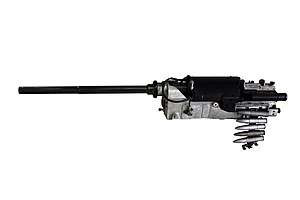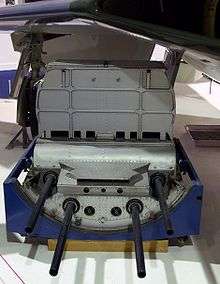ADEN cannon
The Royal Small Arms Factory ADEN is a 30 mm revolver cannon used on many military aircraft, particularly those of the British Royal Air Force and Fleet Air Arm.[1] Developed post-World War II primarily to meet British Air Ministry's requirement for increased lethality in aircraft armament, the cannon was fired electrically and is fully automatic once it is loaded.[2]
| ADEN cannon | |
|---|---|
 30mm ADEN Mk 4 on display at the Imperial War Museum Duxford | |
| Type | Revolver cannon |
| Place of origin | United Kingdom |
| Service history | |
| Used by | See users |
| Production history | |
| Designer | Armament Development Establishment |
| Designed | 1946 |
| Manufacturer | Royal Small Arms Factory |
| Produced | 1953–present |
| Specifications | |
| Mass | Overall: 87.1 kg (192 lb 0 oz) Barrel: 12.25 kg (27 lb 0 oz) |
| Length | Overall: 1.64 m (5 ft 5 in) |
| Barrel length | 1.08 m (3 ft 7 in) |
| Shell | 30×113mm |
| Barrels | Single barrel (progressive RH parabolic twist, 16 grooves) |
| Action | Gas operation featuring a pneumatic cocking system and a 26 volt DC electrical firing system |
| Rate of fire | 1,200–1,700 rpm |
| Muzzle velocity | 790 m/s (2,600 ft/s) |
Design and development
During World War II, the German firm Mauser began development of a radically new 20 mm autocannon using a motorised firing mechanism in order to improve the rate of fire. By the late-war period the Mauser MG 213 was beginning to mature, but by this time the presence of large bombers like the Boeing B-17 and Avro Lancaster led to the rapid up-arming of Luftwaffe fighter aircraft. Mauser responded by adapting the MG 213 to fire the 30 mm round from the MK 108 cannon. This relatively small 30 mm round had a low muzzle velocity but included a large explosive charge that was useful against non-manoeuvering targets like bombers. Development of this MG 213C version was still ongoing when the war ended.
In the post-war era, the MG 213 became well known in armament circles, and a number of companies took up development. This included the Armament Development Establishment in the UK and GIAT in France. A common 30×113mm round was developed that offered a dramatic improvement in muzzle velocity from the MK 108's 540 m/s to the new design's 790 m/s. This was only slightly lower than contemporary 20 mm cannon like the Hispano Mk. V's 840 m/s, making the new round suitable for use during dogfights as well as against larger targets. The mechanism improved the rate of fire from the Mk. V's 750 rpm to 1,300 rpm, a significant improvement.[3]
The new weapon was quickly developed and production was set up at the Royal Small Arms Factory in Enfield; the name was created by combining the ADE initials of the Armament Development Establishment with N for Enfield, producing ADEN. The ADEN entered service on the Hawker Hunter in 1954, and subsequently used on every British gun-armed aircraft until the advent of the Panavia Tornado in the 1980s.[1] The last version to see production was the Mk. IV. An improved version, the Mk. 5, incorporates a multitude of small changes to improve reliability and increase rate of fire to 1,500–1,700 rounds per minute. No new Mk 5s were built, but many older weapons were converted, being redesignated Mk 5 Straden.[3]
Aircraft using the ADEN 30 as in-built armament have included the A-4S Skyhawk, English Electric Lightning, Folland Gnat (and HAL Ajeet), Hawker Hunter, Gloster Javelin, Saab Lansen, Saab Draken, SEPECAT Jaguar, Supermarine Scimitar, and CAC Sabre. Several podded versions exist, including the installations scabbed below the fuselage of British Hawker Siddeley Harrier (and US Marine Corps AV-8A/Cs) and Sea Harriers and the Swedish FFV Aden, which is used (among others) on the BAE Hawk. The FFV Aden contains the weapon and 150 rounds of ammunition, is 151.57 in (3.85 m) long, and weighs 802.5 lb (364 kg) fully loaded.
GIAT also introduced their version of the design as the DEFA cannon. The two weapons are very similar and can use the same ammunition.[1]

ADEN 25
The ADEN Mk 5 became the basis for the planned ADEN 25, which was to be a somewhat larger weapon (length: 90 inches (2,290 mm), weight: 203 pounds (92.1 kg)) firing the new range of NATO 25 mm ammunition (as in the American GAU-12 Equalizer) at a much higher muzzle velocity of 3,445 feet per second (1,050 m/s). The lighter ammunition was also to produce a higher rate of fire, 1,650 to 1,850 rounds per minute. Severe development problems plagued the ADEN 25, which proved unable to meet its design weight target.[4] It was finally cancelled in 1999. As a result, RAF Harrier GR.7 and GR.9 aircraft did not carry a cannon, no attempt apparently having been made to retrofit the older ADEN 30 mm pods. Fleet Air Arm Sea Harriers retained the 30 mm weapon until their retirement in 2006.
Users
- Danish Air Force
- Indonesian Air Force (TNI-AU)
- Kenyan Air Force
- Qatar Emiri Air Force
- Royal Rhodesian Air Force (later to Air Force of Zimbabwe)
- Somali Air Corps
- Royal Thai Navy Flying Unit
Please note that this list is not exhaustive.
Specifications
Data from Jane's Information Group[1]
- Type: single-barrel automatic cannon
- Caliber: 30 mm (1.18 in) × 113 mm
- Operation: revolver chamber
- Length: 1.64 m (5 ft 5 in)
- Weight (complete): 87.1 kg (192 lb)
- Rate of fire: 1,200–1,700 rpm
- Muzzle velocity: 790 m/s (2,592 ft/s)
- Projectile weight: 220 g (7.76 oz)
See also
- DEFA cannon – comparable French design (shares a common range of 30×113mm NATO rounds)
- Mauser BK-27 – comparable German design
- M39 cannon – comparable US design
References
- Lennox, Duncan (2001). "Guns: ADEN 30 mm cannon (United Kingdom)". Jane's air-launched weapons. Jane's Information Group. ISBN 978-0-7106-0866-6. Archived from the original on 26 January 2013.
- "Aden 30mm Gun Installation". Hawker Hunter. Archived from the original on 24 April 2017. Retrieved 4 February 2011.
- "ADEN 30 mm Cannon MK 4 & 5" (PDF). United Kingdom: AEI Systems Ltd. Archived from the original (PDF) on 2 January 2014. Retrieved 4 February 2011.
- http://www.forecastinternational.com/archive/disp_pdf.cfm?DACH_RECNO=1059